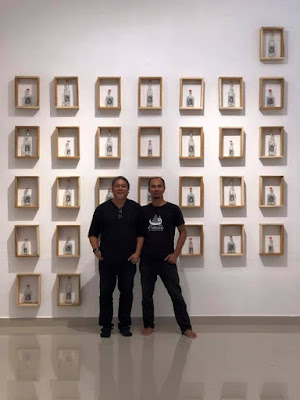Patani Art Space
17/7 Donrak ,NongChik ,Pattani
Amphoe Nong Chik
Patani.artspace@gmail.com
Call: 093 579 4264
Opening Art Exhibition
Calendar of life
By Pichet Piaklin
Jehabdulloh Jehsorhoh
At Patani Art Space
Alhamdulillah ผ่านไปอย่างราบรื่นกับ
บรรยากาศพิธีเปิดนิทรรศการศิลปะ "ปฏิทินชีวิต"
โดย พิเชษฐ์ เปียร์กลิ่น
เจะอับดุลเลาะ เจ๊ะสอเหาะ
ณ Patani Art Space
Silat is a collective word for a class of indigenous martial arts from a geo-cultural area of Southeast Asia encompassing most of the Nusantara, the Indonesian Archipelago, the Malay Archipelago and the entirety of the Malay Peninsula. Originally developed in what are now Indonesia, peninsular Malaysia, south Thailand, and Singapore, it is also traditionally practised in Brunei, central Vietnam and the southern Philippines. There are hundreds of different styles (aliran) and schools (perguruan) but they tend to focus either on strikes, joint manipulation, throws, weaponry, or some combination thereof. Silat is one of the sports included in the Southeast Asian Games and other region-wide competitions. Training halls are overseen by separate national organisations in each of the main countries the art is practised. These are Ikatan Pencak Silat Indonesia (IPSI) from Indonesia, Persekutuan Silat Kebangsaan Malaysia (PESAKA) from Malaysia, Persekutuan Silat Brunei Darussalam (PERSIB) from Brunei and Persekutuan Silat Singapura (PERSISI) from Singapore. Practitioners are called pesilat.
While the word silat is used by Malay-speakers throughout Southeast Asia, the art is officially called pencak silat in Indonesia. Primarily a Javanese term, other names include silek (the Minang pronunciation of silat), penca (used in West Java), main-po or maen po (in the lower speech of Sundanese), and gayong or gayung (used in parts of Malaysia and Sumatra). The clear distinction between Indonesian and Peninsular silat is a relatively recent one based mainly on post-independence patriotic sentiments. The term silat Melayu ("Malay silat") was originally used in reference to Riau but is today commonly used for referring to systems created on the Southeast Asian mainland. Generally speaking, silat Melayu is often associated with fixed hand positions, low stances, and slow dance-like movements. While this generalisation does not necessarily reflect the reality of silat techniques, it has had a notable influence on the stereotypical way the art is portrayed in Malaysia, Singapore, and to a lesser extent, Brunei.





























































































